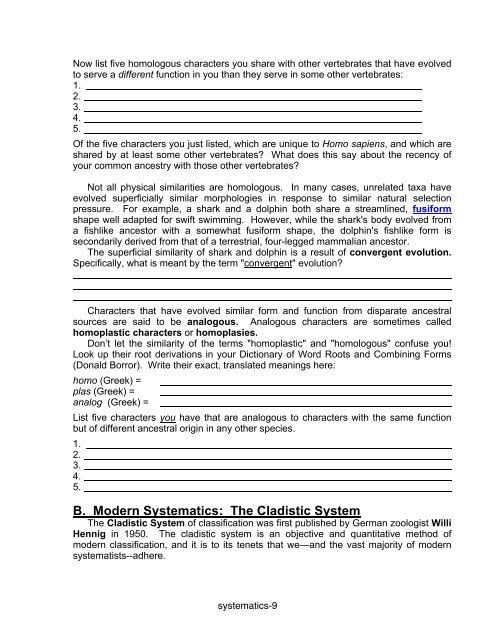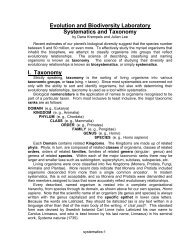Evolution and Biodiversity Laboratory Systematics and Taxonomy
Evolution and Biodiversity Laboratory Systematics and Taxonomy
Evolution and Biodiversity Laboratory Systematics and Taxonomy
Create successful ePaper yourself
Turn your PDF publications into a flip-book with our unique Google optimized e-Paper software.
Now list five homologous characters you share with other vertebrates that have evolvedto serve a different function in you than they serve in some other vertebrates:1.2.3.4.5.Of the five characters you just listed, which are unique to Homo sapiens, <strong>and</strong> which areshared by at least some other vertebrates? What does this say about the recency ofyour common ancestry with those other vertebrates?Not all physical similarities are homologous. In many cases, unrelated taxa haveevolved superficially similar morphologies in response to similar natural selectionpressure. For example, a shark <strong>and</strong> a dolphin both share a streamlined, fusiformshape well adapted for swift swimming. However, while the shark's body evolved froma fishlike ancestor with a somewhat fusiform shape, the dolphin's fishlike form issecondarily derived from that of a terrestrial, four-legged mammalian ancestor.The superficial similarity of shark <strong>and</strong> dolphin is a result of convergent evolution.Specifically, what is meant by the term "convergent" evolution?Characters that have evolved similar form <strong>and</strong> function from disparate ancestralsources are said to be analogous. Analogous characters are sometimes calledhomoplastic characters or homoplasies.Don’t let the similarity of the terms "homoplastic" <strong>and</strong> "homologous" confuse you!Look up their root derivations in your Dictionary of Word Roots <strong>and</strong> Combining Forms(Donald Borror). Write their exact, translated meanings here:homo (Greek) =plas (Greek) =analog (Greek) =List five characters you have that are analogous to characters with the same functionbut of different ancestral origin in any other species.1.2.3.4.5.B. Modern <strong>Systematics</strong>: The Cladistic SystemThe Cladistic System of classification was first published by German zoologist WilliHennig in 1950. The cladistic system is an objective <strong>and</strong> quantitative method ofmodern classification, <strong>and</strong> it is to its tenets that we—<strong>and</strong> the vast majority of modernsystematists--adhere.systematics-9

















